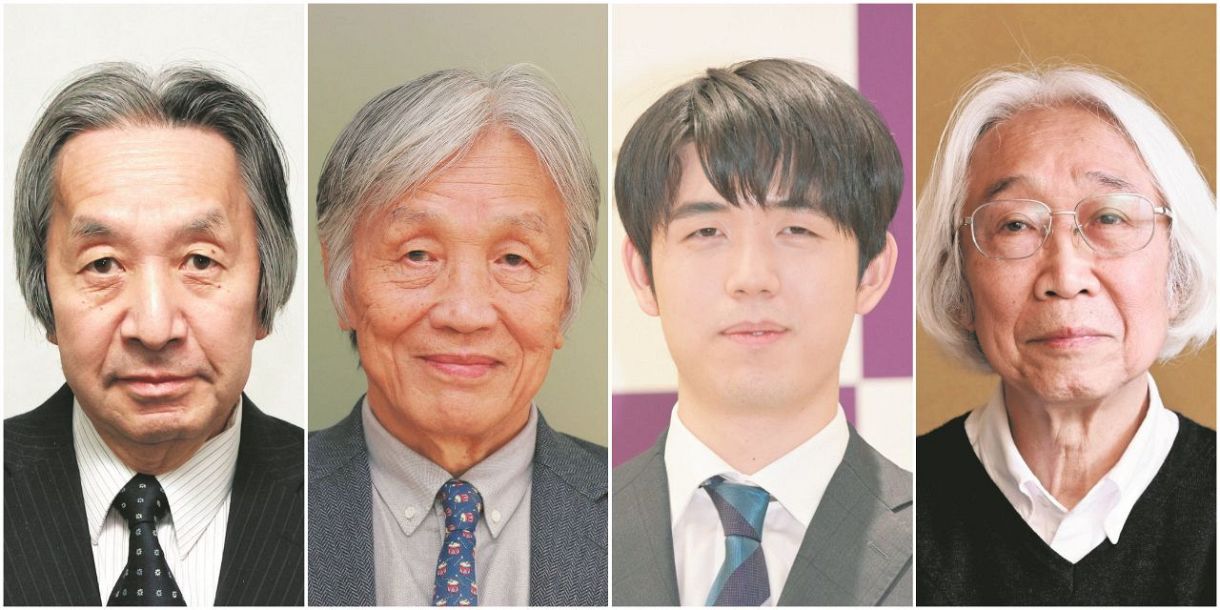Four people have been selected as the winners of the 77th Chunichi Cultural Award by Chunichi Shimbun (Tokyo Shimbun).
Founded by Chunichi Shimbun in 1947 to commemorate the enforcement of the Japanese Constitution. The award is given to individuals and organizations connected to the Chubu region who have contributed to the improvement of culture in fields such as academics, humanities, and the arts. Each winner will receive a main prize, a watch, a supplementary prize of 1 million yen, and a certificate.
From left, Masahiro Hara, Masato Sagawa, Sota Fujii, and Kunie Komori, who were selected to receive the Chunichi Cultural Prize.
Award winners and achievements (in no particular order)
Mr. Masahiro Hara, chief engineer of DENSO WAVE(66)
= Nagoya City = “Contributing to a digital society through the development and dissemination of QR codes”
Daido Special Steel Advisor Mr. Masato Sagawa(80)
= Kyoto City = “Invention of neodymium magnets and promotion of a decarbonized society”
Shogi player Sota Fujii(21)
= Seto City, Aichi Prefecture = “Monopoly of the eight major shogi titles and promotion of shogi culture”
Mr. Kunie Komori, lacquer artist and holder of important intangible cultural property “Kyushitsu”(79)
= Wajima City, Ishikawa Prefecture = “Creative lacquer expression and contribution to Wajima lacquer production area”
◇ ◇
◆Masahiro Hara’s QR code inspired by Go stones: “We were praised for creating culture.”
Cashless payments, electronic tickets… “QR code” can read various information at high speed. The black and white mosaic pattern is celebrating its 30th anniversary this year, and not a day goes by that I don’t see it. “I’m really happy that my work in creating culture has been recognized,” he said, expressing his joy at receiving the award.
Development began in 1992 during the Denso era for production management at an auto parts factory. Until then, barcodes had been used, but as parts became more diverse, production sites required tools that could store larger amounts of information.
Masahiro Hara of Denso Wave
The 2D code, which reads information both vertically and horizontally, was inspired by Go, a game he played as a hobby since he was a child. When she saw the white and black Go stones arranged randomly on a Go board, she had an epiphany: “You can recognize the situation without filling in all the squares.” Square patterns are placed in the three corners to serve as landmarks, making it instantly readable from any direction.
QR codes, developed in 1994, contain approximately 200 times more information than barcodes and can be read even if a portion is missing. The acquired patents were released free of charge in order to prioritize their dissemination. With the advent of camera-equipped cell phones in the 2000s, use expanded to the general public. “I chose the right path,” I nod.
When he was in elementary school, he decided to become an engineer after watching the Apollo 11 moon landing broadcast on TV. He still goes to the site, listens to the needs of users, and spares no effort in making improvements. Looking ahead to further evolution, he says, “In the future, we would like to be able to store not only textual information, but also more information such as patient X-ray images.” (Yoshinobu Hirai)
Masahiro HaraBorn in Tokyo in 1957. He graduated from Hosei University. In 1980 he joined Nippondenso (now Denso). In 2023, he will receive the Imperial Gift Award and the Japan Academy Award.
◆Masato Sagawa contributes to a decarbonized society with neodymium batteries “For people to continue living on the earth”
Neodymium magnets are essential for electric vehicle (EV) motors. As a salaried researcher, he successfully developed the “world‘s strongest permanent magnet.” He is delighted, saying, “It’s an honor to receive an award that represents the central region of Japan.”
Shortly after his birth, he left Tokushima during the war and grew up in Naka Town, Gifu Prefecture (now Kakamigahara City), where his father worked. Carrying him on his mother’s back, he fled from an air raid. After the war, he returned to Tokushima, where his father read to him a newspaper article by Hideki Yukawa, which fueled his desire to become a scientist.
Mr. Masato Sagawa, Daido Special Steel Advisor
After graduating from Tohoku University Graduate School, he started working at Fujitsu. He was instructed to increase the strength of permanent magnets, which were considered the strongest at the time, and although he pursued an even stronger magnet, he was told to abandon his pursuit. He retired at the age of 38 and continued his research at Sumitomo Special Metals (now Proterial), where he created a neodymium magnet made of the rare earth elements neodymium, iron, and boron.
A permanent magnet that continuously generates its own magnetic field, and the magnetic force is twice that of conventional permanent magnets. Because it generates a large amount of power with a small amount of electricity, it has led to energy savings in air conditioners and other devices. It is also playing a role in achieving a carbon-neutral society, where greenhouse gas emissions are reduced to virtually zero.
The Daido Steel Group, which became independent in 1988 and inherited the technology, began mass producing neodymium magnets. He also serves as a senior fellow at Meijo University’s Carbon Neutrality Research Promotion Organization, and tells students, “I want to convey to students that carbon neutrality is an important research theme in order for humans to continue living on Earth.” (Rinpei Suzuki)
Masato SagawaBorn in Tokushima City in 1943. He graduated from Kobe University and completed a doctoral program at Tohoku University Graduate School. In 2022, he won the Queen Elizabeth Prize in Engineering.
